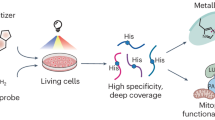Abstract
IN a previous paper the presence of a fast-running peak in a column chromatogram of an alkaline hydrolysate of rat thyroid was reported1. This peak, representing an unknown radioactive iodine compound, amounted to 2–5 per cent of the total radioactivity. Further examination of this component by paper chromatography in a tert-pentanol/2N ammonia (1 : 1) system disclosed the presence of two radioactive spots in approximately equal amounts. Both substances were readily extracted from aqueous solution with ether and were not absorbed by the acid form of the ion exchange resin ‘Dowex 50’. Neither substance could be detected in ether extracts of thyroid homogenates. These properties suggested that the substances might be artefacts and this was confirmed by the finding that they had the same RF values in an n-butanol/n-pentanol/ammonia system as the artefacts produced by Stanley2 by heating 3-iodo- or 3 : 5-di-iodo-tyrosine in 2 N sodium hydroxide for 16 hr. at 105° C. Hydrolysis of N-acetyl-di-iodotyrosine or N-acetyl-mono-iodotyrosine in 2 N hydrochloric acid or sodium hydroxide for 1 hr. at 100° C. was found to be a quicker method of producing the artefacts, but in contrast to Stanley's finding, only one was produced from each substituted tyrosine. Sufficient material for identification was obtained by hydrolysis of 1 gm. of N-acetyl-di-iodotyrosine in 20 ml. 2 N sodium hydroxide. The hydrolysate was extracted twice with an equal volume of n-butanol and the concentrate applied in a band on three 10-cm. Whatman No. 1 papers and developed with tert-pentanol/ammonia. The artefact band was located under an ultra-violet lamp, cut out and eluted with methanol. After removal of the methanol the residue, about 5 mgm., was crystallized from acetic acid. Identity of the material as 3 : 5 di-iodo-4-hydroxybenzaldehyde was established by melting point and mixed melting point (201–202° C.) determinations. The identification was confirmed by comparison of the infra-red absorption spectra of the isolated material and an authentic specimen. Similar treatment of N-acetyl-mono-iodotyrosine gave 3-iodo-4-hydroxybenzaldehyde, which was identified by the above procedure (m.p. and mixed m.p. 113–114° C.). Di-iodo-hydroxybenzaldehyde has been obtained previously from the hydrolysis products of iodinated casein, but could not be isolated from hydrolysed thyroid tissue3.
This is a preview of subscription content, access via your institution
Access options
Subscribe to this journal
Receive 51 print issues and online access
$199.00 per year
only $3.90 per issue
Buy this article
- Purchase on Springer Link
- Instant access to full article PDF
Prices may be subject to local taxes which are calculated during checkout
Similar content being viewed by others
References
Kennedy, T. H., and Purves, H. D., Aust. J. Biol. Sci., [9, 586 (1956)].
Stanley, P. G., Nature, 171, 933 (1953).
Pitt-Rivers, R., Biochem. J., 43, 223 (1948).
Author information
Authors and Affiliations
Rights and permissions
About this article
Cite this article
KENNEDY, T. Identification of Two Artefacts in an Alkaline Hydrolysate of Thyroid Tissue. Nature 179, 50–51 (1957). https://doi.org/10.1038/179050a0
Issue Date:
DOI: https://doi.org/10.1038/179050a0
This article is cited by
Comments
By submitting a comment you agree to abide by our Terms and Community Guidelines. If you find something abusive or that does not comply with our terms or guidelines please flag it as inappropriate.



